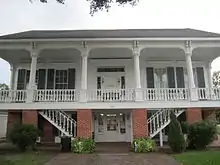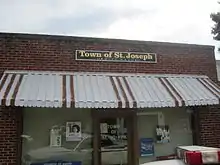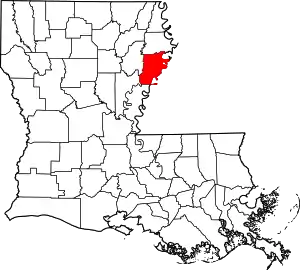St. Joseph, Louisiana
St. Joseph, often called St. Joe, is a town in, and the parish seat of, rural Tensas Parish in northeastern Louisiana, United States, in the delta of the Mississippi River.[3] The population was 1,176 at the 2010 census. The town had an African-American majority of 77.4 percent in 2010.[4]
St. Joseph, Louisiana | |
|---|---|
Town | |
| Town of Saint Joseph | |
_IMG_7488_1.jpg.webp) | |
 Location of St. Joseph in Tensas Parish, Louisiana. | |
.svg.png.webp) Location of Louisiana in the United States | |
| Coordinates: 31°55′07″N 91°14′18″W | |
| Country | United States |
| State | Louisiana |
| Parish | Tensas |
| Government | |
| • Mayor | Elvadus Fields Jr. (D) |
| Area | |
| • Total | 0.89 sq mi (2.31 km2) |
| • Land | 0.89 sq mi (2.31 km2) |
| • Water | 0.00 sq mi (0.00 km2) |
| Elevation | 75 ft (23 m) |
| Population (2010) | |
| • Total | 1,176 |
| • Estimate (2019)[2] | 973 |
| • Density | 1,093.26/sq mi (421.94/km2) |
| Time zone | UTC-6 (CST) |
| • Summer (DST) | UTC-5 (CDT) |
| ZIP code | 71366 |
| Area code(s) | 318 |
| FIPS code | 22-67495 |
History
Unique for the Deep South, St. Joseph was planned and developed in 1843 by European-American settlers around a New England-style village green. The downtown area along Plank Road is listed on the National Register of Historic Places.[5] The area around the town was developed for cotton plantations.
From 1862 to 1865, Louisiana was part of the Confederacy's Trans-Mississippi Department, and St. Joseph operated as a landing for a major route across the Mississippi River. According to the historian John D. Winters in his The Civil War in Louisiana, "Such a strong force of Confederate cavalry occupied the Mississippi side opposite St. Joseph that all Federal attempts to close the transit in January [1865] ended in failure."[6]
In 1879, the Jesse James gang robbed two stores in far western Mississippi, at Washington and Fayette. The gang absconded with $2,000 cash in the second robbery, crossed the river, and took shelter in abandoned cabins on the Kemp Plantation south of St. Joseph. A posse caught up with them, attacking and killing two of the outlaws, but failed to capture the entire gang. Among the deputies was Jefferson B. Snyder, who later was a long-serving district attorney in northeastern Louisiana. Jesse James was killed three years later by one of his own gang members in St. Joseph, Missouri.[7]
St. Joseph is the entry community to Lake Bruin State Park located on Lake Bruin, an oxbow lake of the nearby Mississippi River.
On August 13, 2013, local resident Fuaed Abdo Ahmed took two women and a man hostage at the St. Joseph branch of Tensas State Bank, saying he wanted passage out of the country. After releasing one hostage, he shot one hostage and critically wounded a second before being fatally shot by police.[8][9]
Political history



When Tensas Parish was incorporated in 1901, planter and businessman William Mackenzie Davidson was elected as the first mayor of St. Joseph. Absent competitive politics, given the disenfranchisement of African Americans by the state constitution in 1898, Davidson was re-elected repeatedly, holding the position until his accidental death in January 1930.[11] Davidson was a founder and the general manager of the powerful Panola Company, an agricultural business in St. Joseph. At one point it controlled 10,000 acres of valuable farmland.
Davidson also sat on the board of the Bank of St. Joseph, of which he later became the president. He worked to bring the USDA Agricultural Experiment Station to St. Joseph and lobbied for construction of the Mississippi River bridge to connect the town to Natchez, Mississippi.[12]
Edward L. Brown Sr. was born on October 20, 1952 to son of Leon and Beatrice Brown. He graduated from Grambling State University and is married to Betty S. Brown; the couple has four children. Brown was elected in 2000 as the first African-American mayor of St. Joseph, unseating the long-term white incumbent, Whitfield Jones (February 18, 1929 - August 11, 2013) in the nonpartisan blanket primary.[13] Brown polled 447 votes (64.9 percent) to Jones' 242 (35.1 percent).[14]
Brown was repeatedly re-elected. In the November 6, 2012 election, Brown secured his fourth term with 384 votes (57.7 percent) over Leslie Dandridge Durham, a fellow Democrat who polled 282 votes (42.3 percent).[15]
Prior to 1968, each parish in Louisiana, regardless of population, elected at least one member to the Louisiana House of Representatives. This method of representation resulted in under-representation of the more heavily populated and urbanized parishes. The US Supreme Court ruled on the principle that state legislatures had to establish districts with roughly equal populations, in order to support the principle of equity of "one man, one vote". It said the states had no basis for geographic representation in their legislatures. Given the rural bias and dominance in many state legislatures, many states had not accomplished redistricting since early in the 20th century, although it is to be conducted as needed after every decennial census.
The last state representative member to represent only Tensas Parish was Democrat S. S. DeWitt of Newellton and later St. Joseph. DeWitt represented Tensas Parish from 1964 to 1968. After the state legislature created districts that were roughly equal in population, DeWitt succeeded in being elected again, to serve from 1968 to 1972. He and Lantz Womack of Winnsboro together represented Franklin, Tensas, and Madison parishes. Womack defeated DeWitt in the 1971 primary. DeWitt later switched to Republican Party affiliation.
Water system
In December 2012, St. Joseph residents were placed under an advisory to boil their drinking water because of problems with the aging municipal water system. A mechanical failure at the town treatment plant caused a sudden drop in the water supply. In March 2013, a water main cracked. There are leaks at the base of the city water tower. State Senator Francis C. Thompson, whose district includes Tensas Parish, sought emergency funding for repairs to the system, which serves about seven hundred customers.[16]
In 2016 the town had failed to obtain an approved town audit for the financial year ending 2015, needed by the Louisiana Legislative Auditor's Office to enable progress on the funds. In 2015, it received $553,000 in grants towards the issue. More than $6 million is available once the town's audit is approved by the Auditor's Office.[17]
In December 2016, Governor John Bel Edwards vowed to replace the entire St. Joseph water system. Engineer Bryant Hammett, a Democratic former state representative who performed similar work in his native Ferriday, predicted the project, estimated at $9 million, could be finished by September 2017. Residents were urged not to drink the water or use it in cooking, but they can use it for bathing or washing clothing. The Governor's Office of Homeland Security was providing bottled drinking water for St. Joseph residents.[18]
Geography
According to the United States Census Bureau, the town has a total area of 0.9 square mile (2.3 km2), all land.
Demographics
| Historical population | |||
|---|---|---|---|
| Census | Pop. | %± | |
| 1880 | 486 | — | |
| 1890 | 473 | −2.7% | |
| 1900 | 717 | 51.6% | |
| 1910 | 740 | 3.2% | |
| 1920 | 734 | −0.8% | |
| 1930 | 864 | 17.7% | |
| 1940 | 1,096 | 26.9% | |
| 1950 | 1,218 | 11.1% | |
| 1960 | 1,653 | 35.7% | |
| 1970 | 1,864 | 12.8% | |
| 1980 | 1,687 | −9.5% | |
| 1990 | 1,517 | −10.1% | |
| 2000 | 1,340 | −11.7% | |
| 2010 | 1,176 | −12.2% | |
| 2019 (est.) | 973 | [2] | −17.3% |
| U.S. Decennial Census[19] | |||
_IMG_0265.JPG.webp)
As of the census[20] of 2000, there were 1,340 people, 500 households, and 337 families residing in the town. The population density was 1,505.2 people per square mile (581.3/km2). There were 607 housing units at an average density of 681.9 per square mile (263.3/km2). The racial makeup of the town was 68.58% African American, 29.78% White, 0.22% Asian, 1.04% from two or more races, 00.07% Native American, and 0.30% from other races. Hispanic or Latino of any race were 0.75% of the population.
There were 500 households, out of which 32.2% had children under the age of 18 living with them, 38.2% were married couples living together, 25.0% had a female householder with no husband present, and 32.4% were non-families. 29.2% of all households were made up of individuals, and 14.4% had someone living alone who was 65 years of age or older. The average household size was 2.64 and the average family size was 3.29.
In the town, the population was spread out, with 30.5% under the age of 18, 10.4% from 18 to 24, 26.0% from 25 to 44, 19.7% from 45 to 64, and 13.4% who were 65 years of age or older. The median age was 34 years. For every 100 females, there were 83.8 males. For every 100 females age 18 and over, there were 80.4 males.
The median income for a household in the town was $19,539, and the median income for a family was $22,935. Males had a median income of $22,321 versus $15,288 for females. The per capita income for the town was $9,049. About 33.0% of families and 37.8% of the population were below the poverty line, including 47.5% of those under age 18 and 33.3% of those age 65 or over.
Education
Tensas High School, a consolidation of three former schools, Joseph Moore Davidson High School in St. Joseph, Newellton High School in Newellton, and Waterproof High School in Waterproof, began operating in the fall of 2006 on the Davidson campus. The Tensas Parish School Board has attempted to improve educational quality by focusing on one high school for the entire parish, which has the smallest population of any parish in Louisiana. Troubles broke out at the school on November 2, 2006, and fourteen students were arrested by the sheriff's department.[21] Overt tensions thereafter subsided.
In August 1970, Tensas Academy, a private school, opened in St. Joseph during the first semester of school desegregation after the district was ordered to comply with federal courts. It is still operating.
Notable people
- Daniel F. Ashford (1879-1929), member of the Louisiana House of Representatives from 1916 until his death; planter, first person in Tensas Parish to own an automobile and a wristwatch.[22]
- Clifford Cleveland Brooks, cotton planter, owned Botany Bay plantation on Lake Bruin; member of the Louisiana State Senate from 1924 to 1932[23]
- George Henry Clinton, chemist, lawyer, member of both houses of the legislature from Tensas Parish.[24][25]
- Charles C. Cordill (1855-1916), wealthy cotton planter, state senator from 1884 to 1912; Tensas parish judge and police jury president[26]
- Joseph T. Curry (1895-1961), planter; member of the Louisiana House of Representatives from 1930 to 1944
- Howard M. Jones, state senator from Tensas, Concordia, East Carroll, and Madison parishes from 1960 to 1968
- James E. Paxton (born 1963), St. Joseph lawyer and the district attorney for East Carroll, Madison, and Tensas parishes since 2008[27]
- Robert H. Snyder (died 1906), state representative and Speaker of the Louisiana House of Representatives from 1904 until his death.[28]
References
- "2019 U.S. Gazetteer Files". United States Census Bureau. Retrieved July 25, 2020.
- "Population and Housing Unit Estimates". United States Census Bureau. May 24, 2020. Retrieved May 27, 2020.
- "Find a County". National Association of Counties. Retrieved 2011-06-07.
- "Population of the City of St. Joseph, Louisiana". censusviewer.com. Retrieved July 5, 2012.
- Louisiana Department of Culture, Recreation, and Tourism, St. Joseph, historical marker, St. Joseph, Louisiana, 1982.
- John D. Winters, The Civil War in Louisiana, Baton Rouge: Louisiana State University Press, 1963, ISBN 0-8071-0834-0, pp. 413
- "Jefferson B. Snyder". New Orleans Times-Picayune, April 15, 1938. Retrieved July 22, 2013.
- Associated Press. "Tensas bank suspect blamed ex-girlfriend's family, wanted to leave country, August 15, 2013". Alexandria Daily Town Talk. Archived from the original on August 15, 2013. Retrieved August 15, 2013.
- Jim Mustian (March 12, 2014). "Man who killed hostages in north Louisiana bank had mental illness". Baton Rouge Advocate. Archived from the original on March 13, 2014. Retrieved March 13, 2014.
- "Tensas Parish Library". librarytechnology.org. Retrieved July 17, 2013.
- William M. Davidson obituary, Tensas Gazette, January 24, 1930
- James Matthew Reonas, Once Proud Princes: Planters and Plantation Culture in Louisiana's Northeast Delta, From the First World War Through the Great Depression, pp. 245-248 (PDF). Baton Rouge: Louisiana State University Ph.D. dissertation, December 2006. Archived from the original (PDF) on September 21, 2013. Retrieved July 20, 2013.
- "Whitfield Jones obituary". obitsforlife.com. Retrieved October 4, 2013.
- Louisiana Secretary of State, Primary election Returns, October 7, 2000
- "Louisiana election returns, November 6, 2012". staticresults.sos.la.gov. Retrieved November 11, 2012.
- "Funds sought to fix St. Joseph's water system, May 10, 2013". Monroe News-Star. Retrieved May 11, 2013.
- "Water woes plague St. Joseph". The News Star. Retrieved February 8, 2016.
- Greg Hilburn (December 19, 2016). "Governor to St. Joe residents: 'We're in this with you'". The Monroe News-Star. Retrieved December 20, 2016.
- "Census of Population and Housing". Census.gov. Retrieved June 4, 2015.
- "U.S. Census website". United States Census Bureau. Retrieved 2008-01-31.
- Monroe News-Star, November 3, 2006
- Matthew Reonas, Once Proud Princes: Planters and Plantation Culture in Louisiana's Northeast Delta, From the First World War Through the Great Depression, pp. 262-263 (PDF). Baton Rouge: Louisiana State University Ph.D. dissertation, December 2006. Archived from the original (PDF) on September 21, 2013. Retrieved July 19, 2013.
- Henry E. Chambers, History of Louisiana, Vol. 2 (Chicago and New York City: The American Historical Society, Inc., 1925, p. 71)
- "Membership of the Louisiana House of Representatives, 1812-2012: Tensas Parish" (PDF). legis.la.gov. Archived from the original (PDF) on October 4, 2013. Retrieved July 14, 2013.
- "Membership in the Louisiana State Senate, 1880-2012" (PDF). legis.state.la.us. Retrieved July 15, 2013.
- Tensas Gazette, November 24, 1916
- "James E. Paxton". sixthda.com. Retrieved October 4, 2013.
- "Membership in the Louisiana House of Representatives, 1812-2012" (PDF). legis.state.la.us. Archived from the original (PDF) on December 29, 2009. Retrieved December 29, 2010.
External links
- St. Joseph Progress Community Progress Site for St. Joseph, LA
